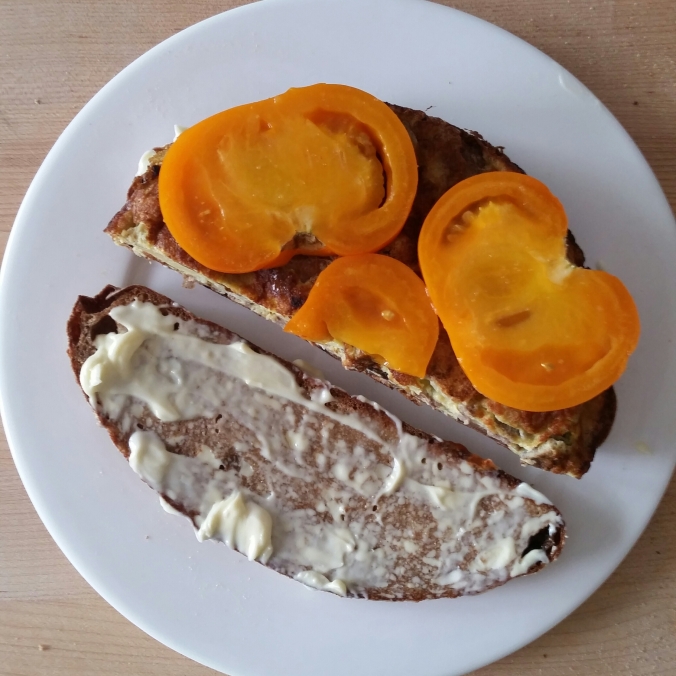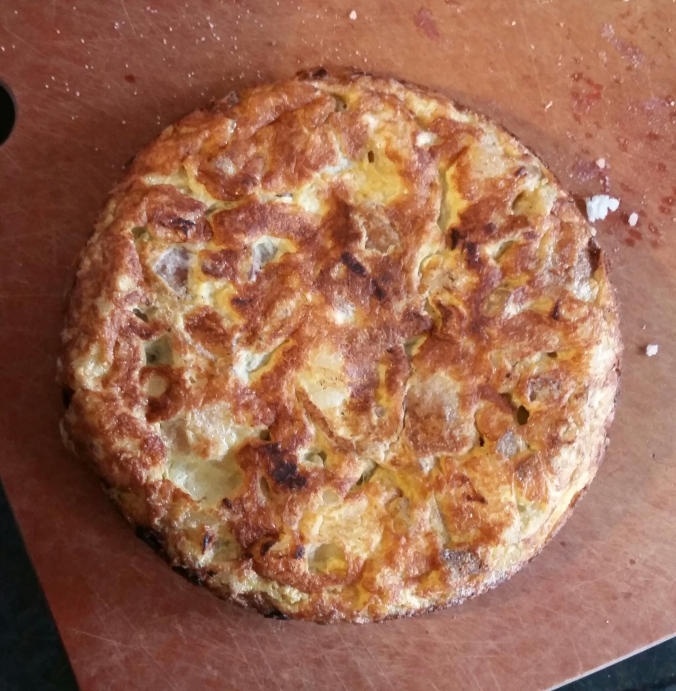I finally figured out a way to eat and enjoy liver! I hid it. In an omelet. In a sandwich. So I can’t taste it. 😀
Here is the history behind how I came to make the bocadillo de tortilla de patatas con hígado, or a Spanish potato and liver omelet sandwich. In full disclosure, I have never been to Spain, and my only experience with Spanish food has been in restaurants and in a friend’s home, so technically, this is Spanish-inspired food.
Sometime around 2003-2004, someone recommended Zarzuela, a tapas restaurant in San Francisco’s Russian Hill neighborhood, to my mom and me. I had never had tapas (or Spanish food) before, and was intrigued. My mom is always up for good food, so we went to Zarzuela and waited outside for what seemed like an eternity for a table. This is where I first had patatas bravas and tortilla española, but more importantly, it’s where I fell in love with olive oil. You read that right. I never appreciated olive oil until I had the olive oil at Zarzuela (probably because I was buying fake olive oils from Safeway). I never bothered to ask what olive oil they used, but I used to dip basketfuls of their soft white bread into the olive oil, which they let you pour freely from the glass bottles on each table. It was very mild and buttery. A few years ago, I went back to Zarzuela after not having eaten there in a long time, and although the food is not as good as I remembered, I still liked the olive oil.
Back to the tortilla española. It is essentially a thick omelet cooked into the shape of a round cake, filled with potatoes and onions. It’s served cold or at room temperature, and it is one of the best human inventions. I can eat it plain, at room temperature or slightly chilled. Fast forward about 10 years from that first tortilla tasting. My friends hosted a paella night at their apartment. In a conversation about the dinner, before the actual dinner, my friend Jaimi told me that in Spain they make sandwiches with the tortilla and that it’s her husband’s favorite food. I thought that was brilliant, except that I wasn’t eating bread at the time (I was eating Paleo), so I couldn’t try it myself.
Fast forward another 2 years to last week. I’m watching Anthony Bourdain’s Parts Unknown on Netflix. It’s the Tangier, Morocco, episode. Tony’s at a well-known café getting high with some locals, and next door to the café is a tiny closet-sized shop (is that the right word for a nook on the side of a building with a window?) from which an older man is frying and selling Spanish-style potato omelets. Tony narrates the instructions for making the omelet and I am mesmerized. There it is! One of my favorite foods being made on television. Tony and his guides sit down on the steps and eat their omelets slathered in mayonnaise and ketchup. My mouth is watering at this point. And I remember Jaimi’s words, “in Spain they make sandwiches with the tortillas.” Then I remember I have some leftover boiled lamb’s liver I wanted to try to eat. I can hide it in the omelet! I also have an open jar of Mark Sisson’s Primal Mayo in the fridge. And some salsa brava from the last time I made Spanish-inspired food. And most importantly, some leftover baked potatoes, half an onion, lots of nice tomatoes from the farmers’ market, and a loaf of Ponsford’s Place’s spicy olive bread. I’m in business!
That was it! A nudge and video recipe from Tony Bourdain, a flashback to Jaimi’s comment about her husband’s favorite food, and a serendipitous supply of all the ingredients I needed, put this beautiful, and extremely delicious and comforting, sandwich in front of me. Now that you know the story behind this sandwich, I won’t keep you waiting any longer. Here is bocadillo de tortilla de patatas con hígado. This is not really a recipe, since it relies on leftovers, but it’s a way to think about using leftovers.
Bocadillo de Tortilla de Patatas con Hígado
makes 2 sandwiches
Equipment: 8″ well-seasoned cast iron skillet, or nonstick pan
Ingredients:
1/4 medium onion, chopped
3 pastured eggs
1/2 teaspoon salt, divided
1/3 cup finely diced boiled lamb’s liver (leftover from the prior week, when I tried really hard to eat liver)
1 small baked or boiled, and chilled, potato (I happened to have small russet potatoes I baked in advance to have around for food emergencies. You should always have baked or boiled potatoes around for food emergencies.)
4 tablespoons Primal Mayo (I like lots of mayo on my sandwiches. I like it to squeeze out the sides.)
salsa brava or harissa, as much as you like
4 thin, whole slices of whole grain sourdough bread, the biggest slices you can find from a round loaf
tomato slices, with salt
Method:
In the cast-iron skillet, fry the onion gently in a generous amount of olive oil, say 2 tablespoons, until soft, but not brown. While the onions are cooking, gently beat the eggs and 1/4 tsp salt with a fork. Use your hands to break up the potato into 1.5″ chunks. Sprinkle the remaining 1/4 tsp salt onto the potatoes and then stir the potatoes and chopped liver into the beaten egg. Strain the onion out of the skillet and into the egg mixture and gently stir again.
Make sure there’s about 1 tablespoon of olive oil in the skillet. Pour the egg mixture into the skillet and let it cook on medium-low heat until the omelet is 3/4 cooked. Then carefully flip the omelet and cook for another minute. Flip the omelet out onto a cutting board.
While the omelet is resting, toast your bread and slather the mayonnaise on all the slices (making sure you line up the toasts so the mayo will end up on the inside of the sandwich!). Then add dollops of salsa brava or harissa, to taste. Cut the omelet in half for the two sandwiches. Top with tomato slices.

The tomato changed color! Or that is some Instagram filter. No, I just made this sandwich two days in a row because I love it so much. And I don’t care for continuity in scenes. This is not Hollywood.
Sandwich the omelet and tomato slices. Hold the top of the bread firmly down while you use a serrated knife to cut the sandwich in half. Enjoy! (Don’t forget to use extra napkins.)




